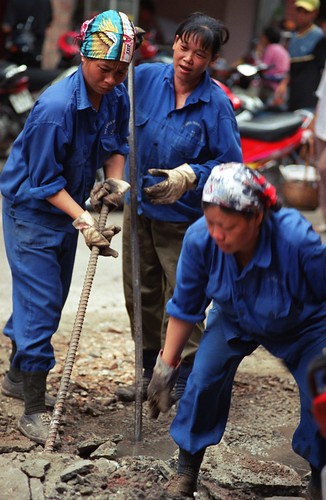As of October 4, 2022, the World Bank has provided US$25.16 billion in grants, concessional loans, and credits to Vietnam through 216 operations since 1993. Vietnam’s existing portfolio consists of 22 active IDA/IBRD financed projects, with a total net commitments of US$4.74 billion. In addition, Vietnam benefits from a large and diverse portfolio of Advisory Services and Analytics (ASA), 20 of which are currently being implemented, leveraging partnerships and trust funds from development partners.
COVID-19 Response
Since COVID-19 hit the country in early 2020, the World Bank Group has worked with Vietnam on multiple fronts to support the national response strategy – from health crisis management to fostering a resilient recovery. Through a grant from the Pandemic Emergency Financing Facility, the World Bank helped ramp up testing capacity for 84 laboratories nation-wide, cutting the turnaround time from 24 to 48 hours to four to six hours. Building on global expertise, the Bank issued a series of policy notes on strategies to protect vulnerable groups from the negative impacts of COVID-19 and to stimulate a broad recovery. During COVID-19, the World Bank conducted seven rounds of household high-frequency surveys, and five rounds of Business Pulse Surveys .
Clean Energy
The Vietnam Renewable Energy Development Project supported some of the first large-scale private-sector led deployments of renewable energy into Vietnam’s power mix. The project provided early-stage investment and technical support to build the requisite capacity and incentives among all stakeholders for scaled-up development. In addition, 19 small hydropower plants were built with a total capacity of 320MW, which supplied an annual volume of 1,260GWh. All these plants followed global best practices on environmental and social risk management, setting new industry benchmarks in Vietnam.
Environment and Natural Resources
The Mekong Delta Integrated Climate Resilience and Sustainable Livelihoods Project, launched in 2016, has helped more than one million farmers in the region transition into more climate-resilient and resource-efficient ways of living. The project leveraged an extensive network of scientists working with farmers to find new production models that best fit the agro-ecological and socioeconomic challenges, and scale them up. It also focused on creating an enabling infrastructure network and on improving regional cooperation on water and land management.
With the support of the World Bank, Vietnam mandated the establishment of a carbon market in January 2022. The Partnership for Market Readiness (PMR) Program helped lay the legal foundation and build capacity for using this market-based instrument between 2016 and 2021. The program supported the government in assessing institutional, policy, and technical gaps for using carbon pricing. It also helped develop the main building blocks for carbon pricing including data collection, measuring, reporting, verifying, and crediting process.
Water Management
The Vietnam-Irrigated Agriculture Improvement Project, which closed in 2021, has helped modernize the irrigation infrastructure in six provinces in the Central and Northern Mountain regions of Vietnam. The project supported a total area of nearly 95,000 hectares, enabling the application of climate-smart agricultural practices by nearly 252,000 farmer households. These practices helped farmers reduce production inputs, save water, and boost incomes per hectare per crop by nearly six-fold. It was estimated that farming practices supported by the project helped reduce 4.3–4.4 tons of CO2-equivalent per hectare per year. Many lessons learned from the project are now being scaled up by the Ministry of Agriculture and Rural Development.
The Dam Rehabilitation and Safety Improvement Project, which started in 2016, supports the implementation of the Government’s national dam safety program. This project is critical for ensuring water security and protecting downstream regions from potential dam failures. The project has so far helped improve the physical safety conditions of 438 multi-purpose dams, out of a total of 477 dams supported by the project, protecting approximately 4.3 million people in downstream communities. Dam safety management has been modernized with the use of geotagging technology and guidelines and procedures towards safety inspection and reporting.
Urban Development and Disaster Risk Management
The Emergency Natural Disaster Reconstruction Project helped four disaster-affected provinces reconstruct and rehabilitate infrastructure and strengthened government capacity to respond to future disaster events. The project improved access to resilient transport, flood prevention and control, irrigation, and drainage infrastructure assets for nearly 1.3 million people. It also addressed institutional gaps for effective disaster risk management and prepared plans for integrated flood risk management in key river basins.
Agriculture and Rural Development
The Results-Based Rural Water Supply and Sanitation Under the National Target Program helped address one of the biggest challenges in rural Vietnam by investing in physical infrastructure and improving the legal framework for sustained access to water supply and sanitation services. Between 2013 and 2019, more than one million people got access to sustainable water supply systems through 400,000 new functioning water supply connections. In addition, about 1.4 million people in 203 communes gained access to commune-wide sanitation. Improved sanitary latrines were built in some 142,000 households and 1,500 schools.
The Vietnam Agriculture Sustainable Transformation Project benefited around one million people living in the Mekong Delta and Central Highlands. Through the rolling out of good agriculture practices, the project beneficiaries improved farming efficiency, increased farm incomes, and reduced environmental pollution and GHG emissions in rice and coffee production. By the time of project closing, more than 220,000 farm households had adopted GAP over 255,000 hectares farmland, farming profit increased by more than 20 percent, CO2e emission reduced by over 1.5 million tons from rice farming annually.
Human Capital
Education
The recently completed Vietnam Enhancing Teacher Education Program improved the quality of teaching and learning by delivering online continuous professional development training to more than 530,000 teachers and school principals in general education. Similarly, the Vietnam Quality Improvement of Primary Education for Deaf Children Project developed Vietnam-sign-language based material for primary education, contributing to significantly improving the enrollment and learning results of deaf students.
The Bank also provides strategic advice for Vietnam on how to prepare its workforce for future jobs, including through major investments in universities and advisory services & analytics on skills development for Vietnam. For instance, the Vietnam Support for Autonomous Higher Education Project has helped improve the quality of research, teaching, and management at two leading universities: Vietnam National Agriculture University and Hanoi University of Science and Technology. As of November 11, nearly half a million students from these two universities and the National Economics University have benefited from the project’s interventions through enhanced learning experience while 18 training programs have been granted international accreditations.
Health
The World Bank supports Vietnam’s efforts to provide quality, affordable health care services for all citizens. As the result, in the north of Vietnam, 13.7 million people—many of them in remote areas—have better access to quality healthcare. The Northeast and Red River Delta Regions Health System Support Project improved treatment capacity for 74 public hospitals at the district and provincial levels by investing in upgrades to the medical infrastructure and training for health workers. Key interventions in cardiology, obstetrics/gynecology, pediatrics, oncology, and trauma are now available at these hospitals, sparing patients the need to seek care far from home. The World Bank is extensively supporting the government to strengthen its health financing functions and thus achieve an efficient and fiscally sustainable health system.
Poverty Reduction
Vietnam has made great strides in reducing poverty and improving quality of life for millions. The World Bank has worked closely with Vietnam to address the last mile chronic challenges in poverty eradication. In 2020, the poverty rate was 3.8 percent based on the World Bank lower middle-income poverty line (US$3.65/day, 2017 PPP).
Last Updated: Nov 7, 2022



